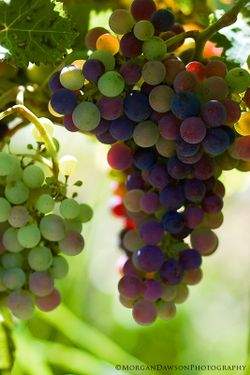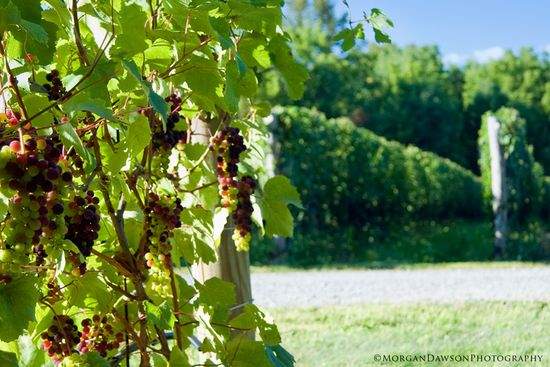By Evan Dawson, Finger Lakes Editor
Photos by Morgan Dawson
Just as hailstorms and cold snaps are destructive to a vineyard, sweeping generalizations are destructive to a harvest report. This year, more than any in recent memory, it is nearly impossible to describe the Finger Lakes pre-harvest conditions in one or two declarative statements. That's because Mother Nature did some — let's just call it like it is — weird, weird stuff this year.
Take the case of Hermann J. Wiemer, which utilizes three vineyards on Seneca Lake. One of them, the HJW vineyard behind the winery itself, endured a recent week in which every afternoon featured a burst of rain that could float your boat (though it hardly floated the boat of local growers). Just 10 miles north, the other two Wiemer vineyards saw nothing more than one passing sprinkle. It was like driving from tropical Florida to arid Arizona in the amount of time it takes Pink Floyd to finish one song.
So yes, conditions vary from vineyard to vineyard, from mesoclimate to mesoclimate. And yes, a lot can change. This piece is an effort to set the stage for what is to come.
"We might not see a single drop of rain until mid-September," says Rochester WHAM-TV meteorologist Mark McLean, inadvertently setting off a celebration across the region. But the challenges started months ago, and while September and October weather matter the most, don't let anyone tell you the early-summer weather means nothing.
"Later blooming varieties like riesling and cabernet franc were largely hit by rain and some cooler temperatures," explains Anthony Road Wine Company winemaker Johannes Reinhardt. He's not talking about veraison; he's talking about spring bloom, when turbulent weather first arrived. "In the worst case, it can mean lighter and smaller clusters."
Why does that matter three months later? Because some of the berries will be small enough that they won't fully ripen. The photograph to the right shows cabernet franc at Anthony Road. Some of the berries are much smaller and won't reach full ripeness. Other clusters show gaps in the grapes with strong variations in berry size. That's not a disaster if the winery knows how to handle it. There are two ways to do it, according to Reinhardt.
"You can hand harvest and hand sort, removing the problems," he says. "But most operations don't have the resources for that, so it comes down to the crusher. If they crush everything as normal it could mean some highly acidic berries get crushed too — and too much acidity in the wines. But if they adjust the crusher to only break the berries of a certain size, problems can be avoided. It's delicate, but if it's done right then the problems of June can be corrected."
In other words, the right winemaker can make all the difference. It's not just the grower. Ah, but the winemaker won't stand a chance if the grower made mistakes, because…
Canopy management will be a huge factor
Ripening lagged from the start, and at one point growers were talking about being two weeks behind ripening schedule. A heat wave to start August sped things up, and now most growers agree that ripening is about five days behind schedule. But just how far behind each vineyard is depends on how growers managed canopies.
"It was a lot of work, but we think we've gotten it to being close to on schedule," says Mike Schnelle of Red Tail Ridge. The main photograph above shows Red Tail Ridge's vines, which looked strong this week. Schnelle has carefully managed canopies to make sure grapes were getting the right sun exposure after an abnormally cool and wet first half of summer.
White Springs Winery's Derek Wilber shot this video to help other growers see how to handle the challenge.
Hybrid growers explain that canopy management was less an issue for them. "With my seyval I didn't do anything different with the canopy," explains Ray Emery, whose Emery Vineyard supplies the seyval for McGreogor Vineyard and Winery on Keuka Lake. "Some of the vinifera folks most likely paid more attention to leaf removal. We are getting ready to go remove the lagging fruit. It will make a difference at harvest."
Regardless of what's already happened, there is a noticeable bounce in the step of Finger Lakes growers and winemakers, because…
September might provide the Cinderella Story
"We were picking grapes in 2000 that made wine that evoked V8 Juice," says Fox Run Winery winemaker Peter Bell. "Trust me, 2009 is not only nothing like that, we'd be fine even without this incredible September weather. Everyone would prefer to be ahead of where we were at the end of August, but this is not unique."
In fact, the extended September forecast of relentless sun, 82-degree highs and 52-degree lows is "absolutely a dream," Bell says. Ripening is catching up in many places, and the warm days and cool nights could provide some excellent structure.
But there's another reason for optimism. Because of the heavy unsold local grape and wine inventory, some growers cut croploads this year — even before the rough early summer weather. That's the case at Anthony Road, where all vineyards now feature two fruiting canes instead of four. Reinhardt figures that will cut down the cropload by about 25%. And that means potentially richer, more complex wines — along with a vineyard that is better equipped to handle challenging conditions. "This was the opportunity to reduce croploads," Reinhardt says. "It's not happening in all vineyards, but you'll notice a difference where it is happening."
So it's too early to declare this an outstanding vintage or a junky one, but it's not too early to say that more than many years, the better wines this year will come from the best vineyards AND the winemakers with a deft hand after picking. Customers should learn as much as they can about the vineyard and winemaking practices behind the bottles that will eventually come out. And if the weather continues to sparkle, it will be instructive to find out when producers decide to pick. While some growers say they're certain to pick later than normal, others seem beholden to a picking schedule that might bring the grapes in before they're optimal.
And if Mother Nature gets her crazy on once again, we'll come back and reassess everything.



